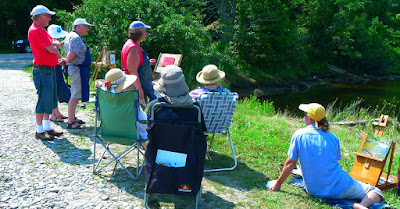Some things I think are invaluable, and a few that I don’t.
Do you have a beginner artist on your list? A good place to start is with a gouache kit and a spiral-bound field sketchbook. This is an inexpensive way to start learning about painting.
Every year, a million knock-off French box easels appear nestled under aspiring artists’ Christmas trees. Don’t buy one if you really love the recipient: they’re heavy, cumbersome, and discouraging. I’d rather see a painter start with a $15 tripod easel and a folding table than with a box easel. I did.
For the watercolor plein air artist, something with a swivel head is the best option. Poppy Balser paints with a Soltek easel; I use a Mabef field easel. En Plein Air also makes a very lightweight sketch easel.
 |
| A compass is a good stocking stuffer for the field artist. |
For oil painters, a pochade box and tripod is a better option. Guerrilla Painter boxes have flooded the market. If you buy one, keep it small; my large one is too heavy for serious field work. Open M boxes are beautifully-made and very expensive. Good with your hands? Here’s a pochade box I built for under $50; it serves me well and it can be paired with a less-expensive tripod.
If what your artist really needs is a studio easel, I think aluminum mast easels provide good value for money. I use Testrite aluminum mast easels in my teaching studio. If your artist likes to work big, go with their hinged professional model. I’ve had one for decades, and it takes work up to 60” square without complaining. It’s been more reliable than wooden easels in the same price range.
| These Panel-Raks are a devilishly clever idea. I should get some for myself and stop using Bobbi’s. |
Every field artist can use a few extra wet-panel carriers. I like PanelPak wet canvas carriers and Ray-Mar’s Wet Painting Carriers, which are made of corrugated plastic. An inexpensive but invaluable product for the traveling artist is a wet-drying rack. I find myself using Bobbi Heath’s when we travel together.
An invaluable accessory for oil painters is a stainless steel brush tank with a leak-proof lid. Yes, artists can use glass jars with tightly-screwed lids, but they make a mess in the field. Get a small one for the plein air painter. Cared for properly, it will last a lifetime.
 |
| A painter might appreciate the parts to make his or her own watercolor field kit. See below. |
Artists never have enough brushes. Watercolor painters would love new brushes by Rosemary & Co. Although a British-based company, they ship fast and reasonably in the United States. I normally buy Robert Simmons Signet Chungking bristle brushes for oils.
If your pastel artist is still juggling loose boxes of pastels, why not splurge and get him a traveling box? I have an earlier version of the Dakota Traveler, which I love. The Roz Box has its fans as well. Silicone Colour Shapers out-perform tortillons and stumps for blending.
In our house, Santa doesn’t bring presents, but he does fill stockings. He always remembers sketch books. I like Strathmore’s Visual Journals with smooth Bristol paper and #2 mechanical pencils, but you can scale that up or down as your budget requires. You might add micron pens if your list includes teenagers.
 |
| Artists love to experiment. How about a set of sumi-e brushes and some ink? |
I have a Winsor Newton Cotman watercolor pan set for when I’m traveling pared-down. Dedicated watercolorists love to create their own pan sets. Anyone would be thrilled to get this Schmincke empty palette set, but if your painter is young and hip, get him just the empty half-pans, some double-sided tape and a few tins of Altoids. Pair this with a watercolor field book, and he will entertain himself for the rest of the year. If you want to include pigments, here’s my guide to watercolor paints.
A navigational compass and a cheap (because it will get dirty) business card holder are both useful field tools.
Artists are always trying to figure out new techniques for mark-making. Why not get your artist some sumi-e ink, brushesor bamboo pens to really mix it up?
 |
| Art lessons are always good. Here I’m demoing a few years ago in beautiful Belfast, ME. |
And, of course, art lessons are always good. Check at your local art center or museum. Or, send your loved one on my Age of Sailworkshop aboard the schooner American Eagle in June, or my Sea & Sky workshop at Acadia National Park in August.
